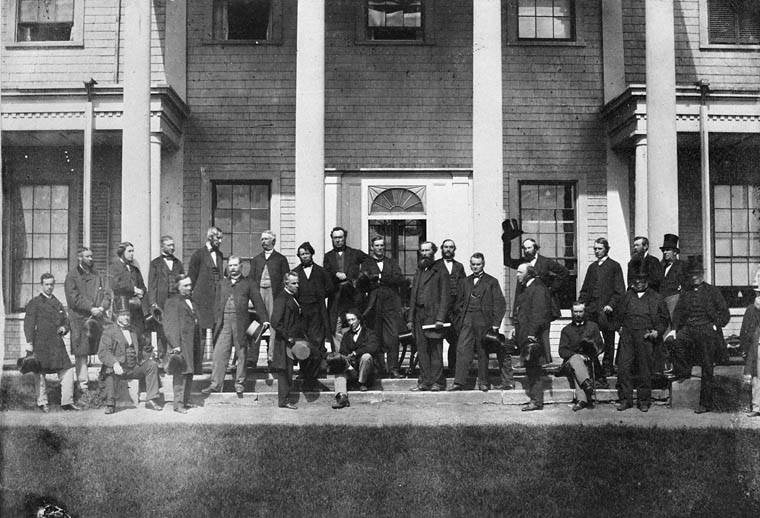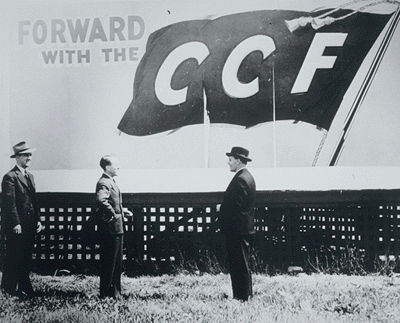Social security refers to government programs that replace people's income lost due to pregnancy, illness, accident, disability, the death or absence of a family's breadwinner, unemployment, old age or retirement. A cornerstone of Canada’s social services, it is a subject of recurring political debate and discussion — and an increasingly important one, as Canada’s population ages.

Confederation
Under the British North America Act (now the Constitution Act of 1867), some of the relatively minor roles of government were assigned to the provinces, rather than the federal government. One of them was the exclusive right to legislate on "the establishment, maintenance and management of hospitals, asylums, charities and charitable institutions.” The implicit thinking was that health and welfare were matters of local interest and control and that the provinces should reassign much of the responsibility to the municipalities or to voluntary charities. Provincial governments, however, became increasingly involved in a range of health and welfare programs, particularly in the western provinces, where municipal organizations were rudimentary or nonexistent.
After 1867, industrialization drew people to towns and cities in search of greater economic opportunity. In the years following Confederation, people's attitudes toward the appropriate role of government in terms of helping people economically were still shaped by the pioneer values of independence and individualism. This was reflected in furious public debates in the 19th century about the necessity for and value of public schools, public-health measures and government regulation of working conditions. Relief for the poor was still delivered in a stigmatizing manner, and poverty, which was related in the public mind to individual failure, was commonly blamed on excessive drinking.
Trade unions, many of which originated at this time, struggled to raise standards of living and to provide income protection against the risk of wage loss, but these limited protections were available only to a minority of the work force. With the increasing industrialization of the late 19th century, the number of work accidents rose. Trade unions and other groups made this a public issue, and the result in 1914 was the first modern social-security program: the Workmen's Compensation Act of Ontario. Injured workers could now claim a regular cash income as a right. Ontario's example was soon copied by other provinces.

Wartime and Depression
The First World War accelerated the processes of urbanization and industrialization, and led to increased agitation for old-age pensions and allowances for civilian widows, deserted wives and their children, as well as family allowance. In 1916, Manitoba was the first province to pass a Mothers' Pensions Act to provide a small but assured income to widows and divorced or deserted wives with children to support — a group of people deemed the "worthy poor." Within five years, all provinces from Ontario west had passed similar legislation. Called "public assistance," the help was based on a means test and constituted a modern version of the English poor law.
In 1919 the federal Liberal Party pledged to pass legislation on health insurance, contributory old-age pensions and unemployment insurance. None of these promises were kept, with the BNA Act cited as the main impediment. But business interests were even more of a hindrance.
To respond to the popular agitation for social legislation and to circumvent the BNA Act, the federal government devised the conditional grant, which enabled it to initiate programs by offering to share the cost of various categories of public assistance with the provinces, which would also be responsible for administering the programs (see Intergovernmental Finance). Under this arrangement the first old-age pension program was introduced in 1927. In 1937 pensions for the blind were added — both examples of restricting aid to the "worthy poor." Programs of this type were subject to a strict and often humiliating means test — further proof that poor-law attitudes still influenced this rudimentary form of social security.
During the Great Depression, thousands of formerly independent Canadians joined the public welfare rolls. The federal government was compelled to become involved in the massive problem of unemployment relief, previously a purely local concern. The 1930 programs to relieve poverty and destitution were essentially left over from the 19th-century poor-relief systems of municipal aid supplemented by voluntary charitable agencies. Rather than cash, assistance was granted in the form of grocery, fuel and clothing orders. Single, unemployed men were herded into military-style camps reminiscent of the 19th-century poorhouse (see Unemployment Relief Camps).
In Alberta non-status Indians and Métis could only collect welfare on "halfbreed" agricultural colonies. By 1939, a majority of Canadians realized that it was the economic and social systems that had failed, and not individuals or families.
The Second World War solved Canada's unemployment problem, and the federal government, previously paralyzed in the face of the social and economic catastrophe of the Great Depression, was able to move with dispatch to organize and finance the war effort. This marked change in government assertiveness was not lost on Canadians. They wanted more positive government action and the political party most in favour of a bigger role for government — the Co-operative Commonwealth Federation, forerunner of the New Democratic Party (NDP) — enjoyed increased electoral success in BC, Saskatchewan and Ontario.

Unemployment Insurance Act of 1940
In 1940, the federal government introduced the Unemployment Insurance Act, which represented a sea-change in Canadian social security arrangements. Unemployment Insurance was Canada's first national social-insurance program (Workmen's Compensation programs were provincial initiatives covering a much smaller segment of the work force for work-related injury, sickness and death). The program's introduction in 1940 was linked to the mobilization of labour, a key element in the war effort. The war effort also resulted in the appearance of the Marsh report of 1943, part of the federal government's plans for postwar reconstruction, and also a morale-building exercise for a country that was experiencing full employment and whose people were telling the politicians that a return to the conditions of the 1930s following the war would not be tolerated. The Report on Social Security for Canada (the Marsh report) provided a blueprint for a comprehensive social-security system built upon a foundation of full employment. It emphasized the use of contributory social insurance to protect the worker against a range of risks to income complemented by a universal system of public health insurance. Although the report had caught the imagination of the country, it was too radical for the federal government, which proceeded to bury it. One suggestion from the Marsh report was selected as a plank for the Liberal Party in the federal election expected in 1945. Thus the introduction of family allowances in 1945 helped the Liberals to another five years as government.
In 1945 the federal government offered its own social-security plan (the Green Book proposals) to the provinces. References to the Marsh report were conspicuous in their absence. In a squabble over revenue-sharing the two levels of government abandoned the plan, which included a cost-shared medical and hospital insurance scheme, federal assumption of old-age pensions at age 70 and a cost shared plan for pensions at ages 65-69, plus federal responsibility for those unemployed who could not qualify for UI benefits.
Parts of the Green Book proposals were resurrected in 1951, when a universal old-age pension at age 70 was instituted, replacing the 1927 legislation and the hated means-test. However a cost-sharing agreement to pay a needs-tested old-age pension to Canadians age 65-69 kept 19th-century poor-law attitudes alive until they were gradually expunged beginning in 1965. What governments were doing at this time was simply filling in the gaps in Canada's social-security system, in response to the strongest political pressure groups. Any notion of comprehensive, coordinated social-security planning was abandoned, and the system grew haphazardly, largely in response to the political winds of the day.
Universal Health Care
Access to health care, always a problem for the poor, became a problem for a majority of Canadians during the Great Depression. Saskatchewan's highly successful hospital insurance plan, which covered every Saskatchewan resident, was launched in 1945. It prompted residents in other provinces to seek similar protection. In 1957 the federal government agreed to share in the cost of provincial hospital insurance programs, and by 1961 all 10 provinces had provided them. The Saskatchewan government, again a pioneer, introduced a universal, tax-supported, publicly administered medical care insurance plan in 1962, the first province or state in North America to do so.
In 1966, the federal government passed the Medical Care Act, according to which it would contribute to provincial medical care insurance. By 1971, all provinces were participating under the terms of the legislation (see Health Policy).
Action to Improve Pensions
In 1965, the federal government passed the Canada Pension Plan, which provided social-insurance protection for retirement, disability and the provision of survivors' benefits. A national program (with the exception of Québec, which legislated the equivalent Quebec Pension Plan), it meant that workers did not lose their membership when changing jobs or moving to another province. It was also the first Canadian social-security program to provide for automatic increases in benefits in accordance with increases in the cost of living (see Old-Age Pension).
Social Security in the 1980s
The 1980s proved to be a testing time for Canada's social-security system. The decade began with double-digit inflation followed by the most severe economic recession (1981-83) since the 1930s. The result was high unemployment, reduced economic growth, a sharp decline in tax revenue with a corresponding increase in government deficits. These circumstances led provincial and federal governments to carefully scrutinize spending on social-security programs and put forward cost-containment proposals. Universal programs such as family allowance and old-age pensions were viewed by some as extravagant in the existing economy, and there were calls for cutbacks to unemployment insurance even as the national rate of unemployment exceeded 11 per cent. Proposals to redesign Canadian social security began to appear.
Canada Health Act
In the opinion of many observers, the Medicare system's goal of providing unfettered access to a comprehensive range of medical services was being increasingly jeopardized in the early 1980s by the practice of extra billing by doctors and the imposition of hospital user fees by some provinces. These practices represented an attempt to compensate for the increasing stringency of both federal and provincial health budgets.
In 1984, with the support of all political parties, the federal government acted to stem the erosion of universal accessibility by passing the Canada Health Act, which reasserted the principle of universal access by requiring the provinces, as a condition for receiving the federal share of provincial health-care costs, to eliminate hospital user fees and extra billing by physicians. Furthermore, health economists argued that a better allocation of existing resources was possible. An attempt to introduce a two-tier system of medical care in Canada was rebuffed by the Canadian public and the system of Medicare remains, though it continues to be an issue of great debate debate, particularly as the Baby Boomers age.

 Share on Facebook
Share on Facebook Share on X
Share on X Share by Email
Share by Email Share on Google Classroom
Share on Google Classroom
